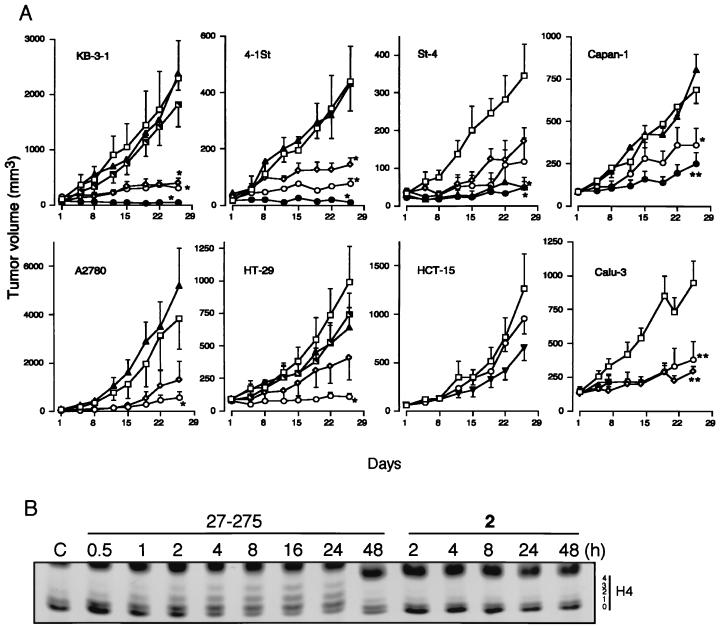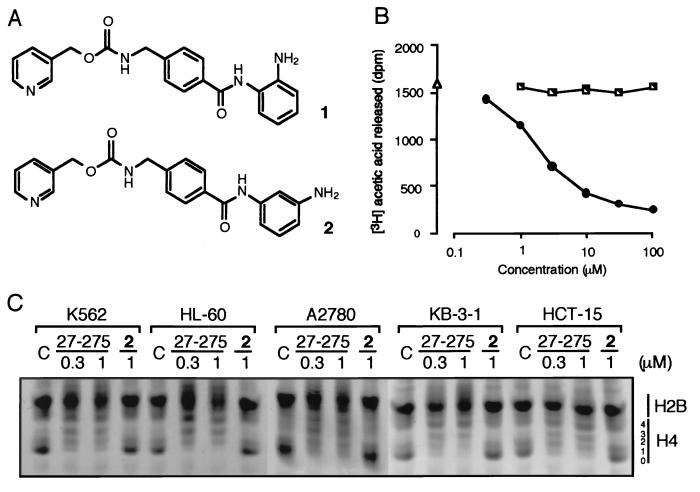
| Size | Price | Stock | Qty |
|---|---|---|---|
| 10mg |
|
||
| 25mg |
|
||
| 50mg |
|
||
| 100mg |
|
||
| 250mg |
|
||
| 500mg |
|
||
| 1g |
|
||
| Other Sizes |
|
Purity: ≥98%
Entinostat (formerly known as MS-275; SNDX-275) is a potent, benzamide-based and class-selective but generally pan-HDAC (histone deacetylase) inhibitor with potential anticancer activity. It is more selective for HDAC1/2/3 over HDACs 4, 6, 8, and 10, and it strongly inhibits HDAC1, HDAC2, and HDAC3 with IC50 values of 0.24, 0.45, and 0.25 μM in cell-free experiments, respectively. By attaching to and inhibiting histone deacetylase, an enzyme that controls chromatin structure and gene transcription, entinostat may have anticancer properties. In human leukemia cells, this agent appears to have dose-dependent effects, including, at low drug concentrations, cyclin-dependent kinase inhibitor 1A (p21/CIP1/WAF1)-dependent growth arrest and differentiation.
| Targets |
HDAC1 ( IC50 = 243 nM ); HDAC3 ( IC50 = 248 nM ); HDAC2 ( IC50 = 453 nM )
|
|
|---|---|---|
| ln Vitro |
|
|
| ln Vivo |
|
|
| Enzyme Assay |
HDAC activity biochemical assays are performed by Nanosyn in 384-well microplates with a reaction volume of 10 μL. Five microliters of a 2× HDAC inhibitor (such as Entinostat), four microliters of 2.5× enzyme, and one microliter of 10× substrate are combined with assay buffer (100 mM HEPES, pH 7.5, 25 mM KCl, 0.1% BSA, 0.01% Triton X-100, 1% DMSO) in a typical enzymatic reaction. In the enzymatic assays, the final concentration of each HDAC ranges from 0.5 to 5 nM. In every experiment, a final substrate concentration of 1 μM FAM-RHKK(Ac)-NH2 or FAM-RHKK(trifluoroacetyl)-NH2 is employed, and it is discovered to be lower than the calculated Km,app for every enzyme[1].
|
|
| Cell Assay |
SH-SY5Y cells are split twice a week and kept in a humidified incubator with 5% CO2 at 37°C under standard culture conditions. After plating cells at a density of 2500 cells per well in a 20-μL volume of DMEM/F-12 culture media supplemented with 10% FBS, the cells are left to adhere for the entire night in black 384-well plates. After being serially diluted in 100% DMSO the next day, HDAC inhibitors (such as Entinostat) are then cross-diluted into culture media. To achieve the desired inhibitor final concentration (e.g., 0.1% DMSO), 5 μL of the compound (e.g., Entinostat) diluted in media is added to the appropriate well of the cell plate. Cellular ATP levels are quantified using CellTiter-Glo reagents after treated cells are incubated for 6, 24, 48, 72, or 96 hours under standard tissue culture conditions. Similarly, media from different cell plates are aspirated after 6 hours of incubation with HDAC inhibitors (such as Entinostat), and cells are once again washed with media free of inhibitors. After 24, 48, 72, or 96 hours of incubation, the cells are given 25 μL of media supplemented with 10% FBS and 0.1% DMSO (no inhibitors), and the levels of cellular ATP are measured using CellTiter-Glo. An Envision Instrument with a 0.1 s count time is used to measure luminosity at each time point[1].
|
|
| Animal Protocol |
|
|
| References |
|
| Molecular Formula |
C21H20N4O3
|
|
|---|---|---|
| Molecular Weight |
376.41
|
|
| Exact Mass |
376.15
|
|
| Elemental Analysis |
C, 67.01; H, 5.36; N, 14.88; O, 12.75
|
|
| CAS # |
209783-80-2
|
|
| Related CAS # |
|
|
| Appearance |
White off white solid powder
|
|
| SMILES |
C1=CC=C(C(=C1)N)NC(=O)C2=CC=C(C=C2)CNC(=O)OCC3=CN=CC=C3
|
|
| InChi Key |
INVTYAOGFAGBOE-UHFFFAOYSA-N
|
|
| InChi Code |
InChI=1S/C21H20N4O3/c22-18-5-1-2-6-19(18)25-20(26)17-9-7-15(8-10-17)13-24-21(27)28-14-16-4-3-11-23-12-16/h1-12H,13-14,22H2,(H,24,27)(H,25,26)
|
|
| Chemical Name |
pyridin-3-ylmethyl N-[[4-[(2-aminophenyl)carbamoyl]phenyl]methyl]carbamate
|
|
| Synonyms |
|
|
| HS Tariff Code |
2934.99.9001
|
|
| Storage |
Powder -20°C 3 years 4°C 2 years In solvent -80°C 6 months -20°C 1 month |
|
| Shipping Condition |
Room temperature (This product is stable at ambient temperature for a few days during ordinary shipping and time spent in Customs)
|
| Solubility (In Vitro) |
|
|||
|---|---|---|---|---|
| Solubility (In Vivo) |
|
| Preparing Stock Solutions | 1 mg | 5 mg | 10 mg | |
| 1 mM | 2.6567 mL | 13.2834 mL | 26.5668 mL | |
| 5 mM | 0.5313 mL | 2.6567 mL | 5.3134 mL | |
| 10 mM | 0.2657 mL | 1.3283 mL | 2.6567 mL |
*Note: Please select an appropriate solvent for the preparation of stock solution based on your experiment needs. For most products, DMSO can be used for preparing stock solutions (e.g. 5 mM, 10 mM, or 20 mM concentration); some products with high aqueous solubility may be dissolved in water directly. Solubility information is available at the above Solubility Data section. Once the stock solution is prepared, aliquot it to routine usage volumes and store at -20°C or -80°C. Avoid repeated freeze and thaw cycles.
Calculation results
Working concentration: mg/mL;
Method for preparing DMSO stock solution: mg drug pre-dissolved in μL DMSO (stock solution concentration mg/mL). Please contact us first if the concentration exceeds the DMSO solubility of the batch of drug.
Method for preparing in vivo formulation::Take μL DMSO stock solution, next add μL PEG300, mix and clarify, next addμL Tween 80, mix and clarify, next add μL ddH2O,mix and clarify.
(1) Please be sure that the solution is clear before the addition of next solvent. Dissolution methods like vortex, ultrasound or warming and heat may be used to aid dissolving.
(2) Be sure to add the solvent(s) in order.
| NCT Number | Recruitment | interventions | Conditions | Sponsor/Collaborators | Start Date | Phases |
| NCT02569320 | Active Recruiting |
Drug: Entinostat Drug: Nivolumab |
Renal Cell Carcinoma | Roberto Pili | August 31, 2018 | Phase 2 |
| NCT02936752 | Active Recruiting |
Drug: Entinostat Biological: Pembrolizumab |
Myelodysplastic Syndrome | National Cancer Institute (NCI) |
April 3, 2017 | Phase 1 |
| NCT03501381 | Active Recruiting |
Drug: Entinostat Drug: Interleukin-2 |
Renal Cell Carcinoma | Roberto Pili | May 24, 2018 | Phase 2 |
| NCT03978624 | Active Recruiting |
Drug: Pembrolizumab Drug: Entinost |
Bladder Cancer | UNC Lineberger Comprehensive Cancer Center |
September 23, 2020 | Phase 2 |
| NCT03280563 | Active Recruiting |
Drug: Entinostat Drug: Exemestane |
Breast Neoplasms | Hoffmann-La Roche | December 26, 2017 | Phase 1 Phase 2 |
|
|---|
 |
 |